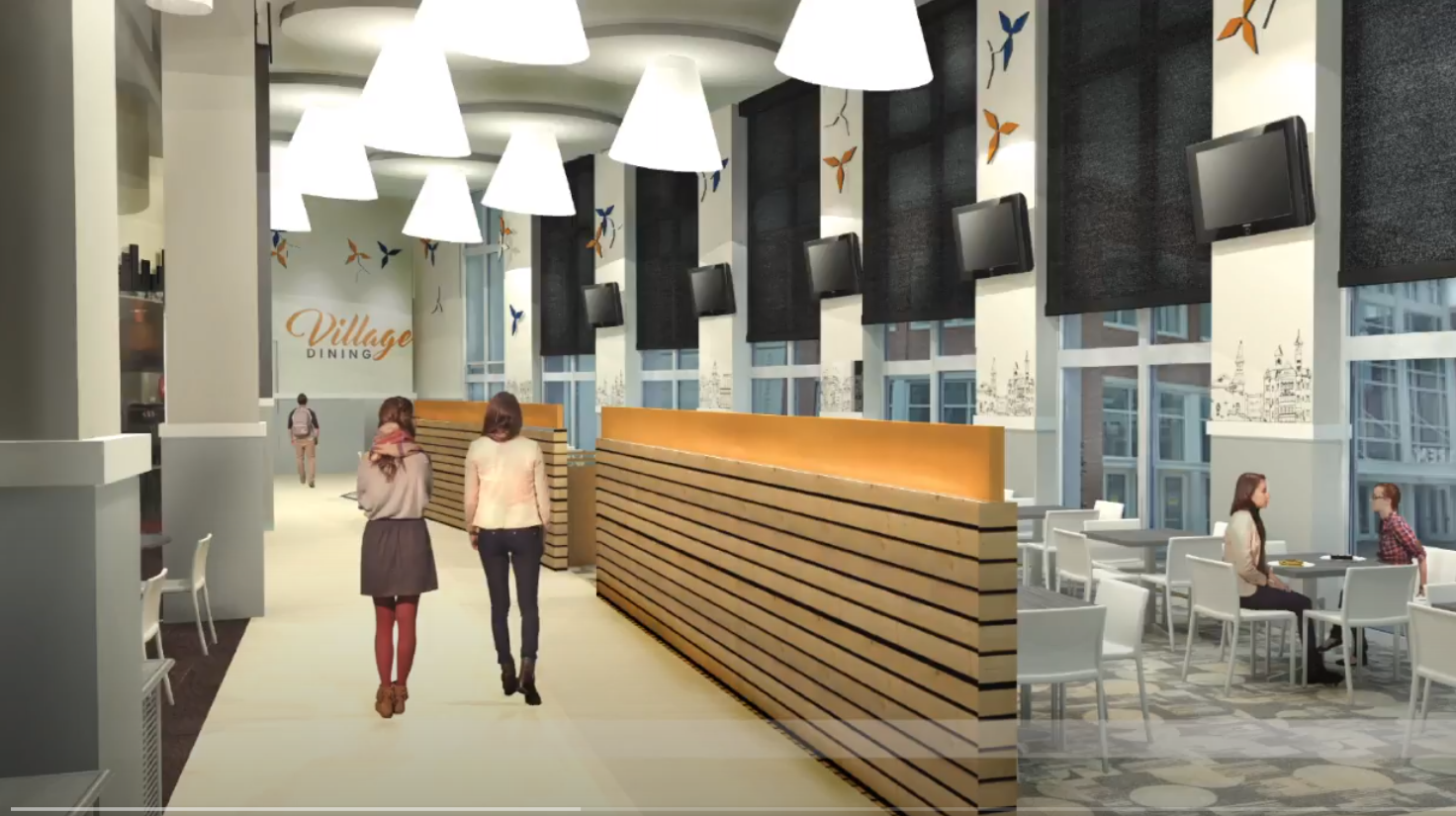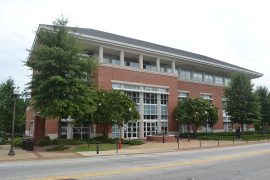Auburn University continues to incorporate sustainability principles into the design, construction, and operation of campus facilities. We currently have 7 LEED certified buildings on campus, with more in the certification process, and continue to strengthen our processes and programs to ensure the incorporation of key sustainability practices and principles as our campus grows and evolves.
Buildings |
Practices
SPOTLIGHTS
Profile
Profile
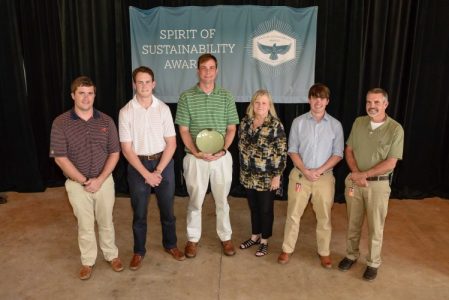
Members of the Energy Management Group gather with their award. From L to R: Adam Pope, Zach Smith, Eric Moore, Dee Gillespie, Scott McClure, and Steven Lloyd.
The Facilities Energy Management (FEM) staff are the largely unseen, unsung heroes when it comes to improving Auburn’s sustainability performance. Energy is one of our biggest challenges and opportunities. Buildings use 40% of total energy consumption in the U.S. and FEM’s purpose is to make sure that Auburn’s buildings operate as effectively and efficiently as possible.
To address energy efficiency, FEM developed an Energy Reduction Strategy, one of the most important climate-related initiatives underway at Auburn. FEM created a set of aggressive energy use reduction goals to lower energy costs and greenhouse gas emissions. FEM uses several strategies to achieve its goals. Nearly every campus building has been metered, resulting in real-time tracking of electricity, gas, and water use. This data is monitored to immediately identify leaks and other issues for rapid response, and to rank buildings so that FEM can prioritize projects to achieve the largest improvements in energy and water use. FEM has developed a building commissioning, recommissioning, and retrocommissioning program to improve and upgrade building mechanicals to ensure efficient and optimal operating conditions, saving money and reducing greenhouse gas emissions.
Project
Thanks to collaborative efforts between the College of Human Sciences, Facilities Management, and Tiger Dining, we can enjoy a freshly renovated and more sustainable dining space at Village Dining. We hope you’ll visit the new space as you grab a bite for lunch or dinner, and enjoy gathering with good friends over great food!
Points of Performance
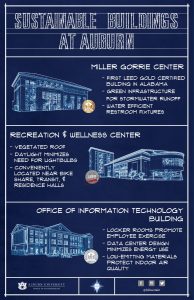 Help us spread the facts on green buildings at Auburn by downloading and sharing our poster, and then spend some time learning the details about a few of the people and projects that help create our success.
Help us spread the facts on green buildings at Auburn by downloading and sharing our poster, and then spend some time learning the details about a few of the people and projects that help create our success.
Amanda Gale
Anna Ruth Gatlin
Dan Bennett
Energy Management Group
Judd Langham
Libraries & Facilities Management
Michael Hein
Sushil Bhavnani
Office of Information Technology Building
2016 REPORT CARD
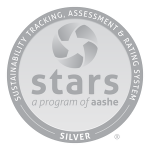
Auburn earned a Silver rating in 2016.
The buildings credits in AASHE STARS “seek to recognize institutions that are taking steps to improve the sustainability performance of their buildings.” Buildings use a large amount of energy, generate significant greenhouse gas emissions, and use considerable amounts of potable water on campus. Institutions can design, build, and maintain buildings in ways that provide a safe and healthy indoor environment for inhabitants, while simultaneously mitigating the building’s impact on the outdoor environment.
Below you can find out more about the specifics of Auburn’s performance in each of the credit areas, as well as how our efforts compare to those of other doctoral institutions who have also completed the STARS 2.0 assessment. *
OP-3: Building Operations and Maintenance 0.00/4.00
This credit recognizes institutions that operate and maintain their buildings in ways that protect the health of building occupants and the environment. An institution’s existing building stock is typically the largest source of campus energy consumption and greenhouse gas emissions. By adopting and following a sustainable operations and maintenance framework, institutions can conserve energy and water, minimize impacts on the surrounding site, reduce waste and water consumption, promote indoor environmental quality, and support markets for environmentally preferable materials while providing healthy and productive work, learning, and living spaces. While other credits also capture many of the impacts of green buildings (e.g. on campus energy consumption and water use), this credit specifically recognizes institutions that have comprehensive sustainable operations and maintenance programs and that pursue third party certification for those programs.
OP-4: Building Design and Construction 0.07/3.00
This credit recognizes institutions that have incorporated environmental features into their design and construction projects. Decisions made during the design phase, such as where to locate the building and how it is oriented, can yield significant energy savings and reduce impacts on the site. By designing and building for enhanced indoor environmental quality (IEQ), institutions can ensure their buildings provide safe, healthy, and productive spaces for the campus community. While other credits also capture many of the impacts of green buildings (e.g. on campus energy consumption and water use), this credit recognizes institutions that have comprehensive green construction and renovation programs and that pursue third party certification of new campus buildings.
OP-5: Indoor Air Quality 1.00/1.00
This credit recognizes institutions that are working to protect the human health of building occupants by monitoring and protecting indoor air quality. Institutions can promote productivity in the workplace and classroom by improving ventilation and managing exposure to indoor pollutants. This creates safe learning, living, and work environments and reduces illnesses for students and staff alike.
Collectively these efforts place us in the middle of the 1st quartile, when compared to other doctoral institutions that have completed the STARS 2.0 assessment.

* Language adapted from the official STARS 2.0 Technical Manual.
2016 PRACTICES IN PLACE
At the time of our STARS submission, some of our sustainable building practices included:
Indoor Air Quality Management Program
Our LEED certified buildings at the time:
KEY PARTNERS AND PLANS
The successes of sustainable buildings at Auburn wouldn’t be possible without the foresight and determination of many units across campus and in the community. We hope you’ll choose to learn more about these important partners and the services and programs they offer the Auburn Family.
Facilities Management — Building Services
Facilities Management — Construction Management
Facilities Management — Design Services
GET INVOLVED
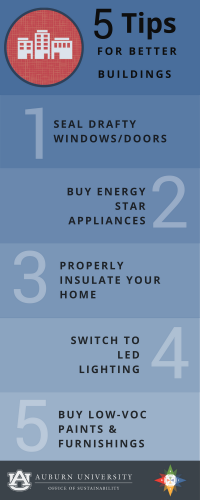 More sustainable practices within your home can serve as a great start to making a difference, but you can also help improve our world by joining with others to work on these challenges at a larger scale. Consider connecting with one of the following groups or academic units to meet others interested in working on these issues, too.
More sustainable practices within your home can serve as a great start to making a difference, but you can also help improve our world by joining with others to work on these challenges at a larger scale. Consider connecting with one of the following groups or academic units to meet others interested in working on these issues, too.
Organizations
Interior Designer Student Groups
College of Architecture, Design, and Construction School Council
US Green Building Council Students: Auburn University
Degree Options
Master in Materials Engineering
Minor in Industrial and Graphic Design Processes
2016 STARS Report Score


